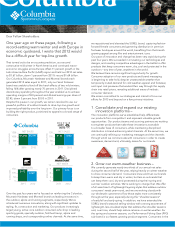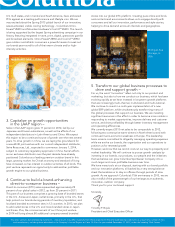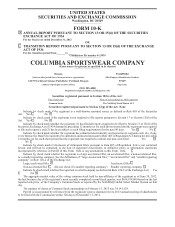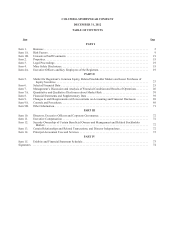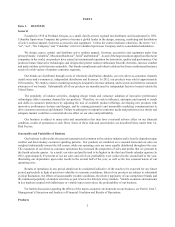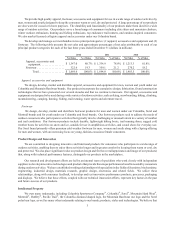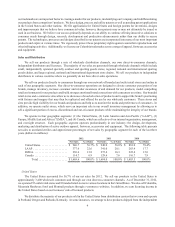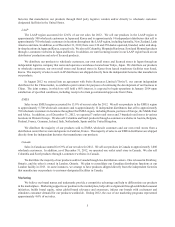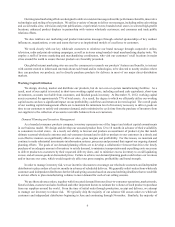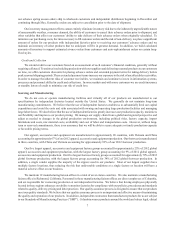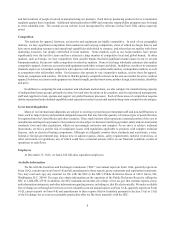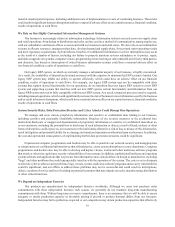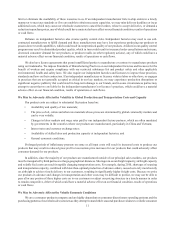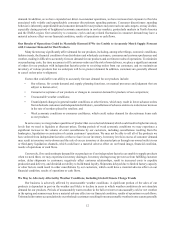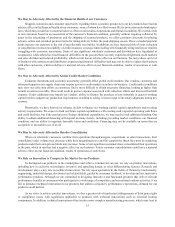Columbia Sportswear 2012 Annual Report Download - page 10
Download and view the complete annual report
Please find page 10 of the 2012 Columbia Sportswear annual report below. You can navigate through the pages in the report by either clicking on the pages listed below, or by using the keyword search tool below to find specific information within the annual report.6
Our integrated marketing efforts are designed to deliver consistent messages about the performance benefits, innovative
technologies and styling of our products. We utilize a variety of means to deliver our messages, including online advertising
and social media sites; television and print publications; experiential events; branded retail stores in selected high-profile
locations; enhanced product displays in partnership with various wholesale customers; and consumer and trade public
relations efforts.
We also reinforce our marketing and product innovation messages through selected sponsorships of key outdoor
influencers, organizations, events and teams that serve as inspirational models of excellence to customers.
We work closely with our key wholesale customers to reinforce our brand message through cooperative online,
television, radio and print advertising campaigns, as well as in stores using branded visual merchandising display tools. We
employ a staff of in-store marketing and merchandising coordinators, who visit our customers’ retail locations in major
cities around the world to ensure that our products are favorably presented.
Our global internet marketing sites are used by consumers to research our products’ features and benefits, to interact
with content created to inform and entertain about each brand and its technologies, to be directed to nearby retailers where
they can purchase our products, and to directly purchase products for delivery in most of our major direct-distribution
markets.
Working Capital Utilization
We design, develop, market and distribute our products, but do not own or operate manufacturing facilities. As a
result, most of our capital is invested in short-term working capital assets, including cash and cash equivalents, short-term
investments, accounts receivable from customers, and finished goods inventory. At December 31, 2012, working capital
assets accounted for approximately 77% of total assets. As a result, the degree to which we efficiently utilize our working
capital assets can have a significant impact on our profitability, cash flows and return on invested capital. The overall goals
of our working capital management efforts are to maintain the minimum level of inventory necessary to deliver goods on
time to our customers to satisfy end consumer demand, and to minimize the cycle time from the purchase of inventory from
our suppliers to the collection of accounts receivable balances from our customers.
Demand Planning and Inventory Management
As a branded consumer products company, inventory represents one of the largest and riskiest capital commitments
in our business model. We design and develop our seasonal product lines 12 to 18 months in advance of their availability
to consumers in retail stores. As a result, our ability to forecast and produce an assortment of product styles that match
ultimate seasonal wholesale customer and end-consumer demand and to deliver products to our customers in a timely and
cost-effective manner can significantly affect our sales, gross margins and profitability. For this reason, we maintain and
continue to make substantial investments in information systems, processes and personnel that support our ongoing demand
planning efforts. The goals of our demand planning efforts are to develop a collaborative forecast that drives the timely
purchase of an adequate amount of inventory to satisfy demand, to minimize transportation and expediting costs necessary
to deliver products to customers by their requested delivery dates, and to minimize excess inventory to avoid liquidating
excess, end-of-season goods at discounted prices. Failure to achieve our demand planning goals could reduce our revenues
and/or increase our costs, which would negatively affect our gross margins, profitability and brand strength.
In order to manage inventory risk, we use incentive discounts to encourage our wholesale customers and independent
distributors to place orders at least six months in advance of scheduled delivery. We generally solicit orders from wholesale
customers and independent distributors for the fall and spring seasons based on seasonal ordering deadlines that we establish
to aid our efforts to plan manufacturing volumes to meet demand for each of our selling seasons.
We use those advance orders, together with forecasted demand from our direct-to-consumer operations, market trends,
historical data, customer and sales feedback and other important factors to estimate the volumes of each product to purchase
from our suppliers around the world. From the time of initial order through production, receipt and delivery, we attempt
to manage our inventory to reduce risk. We typically ship the majority of our advance fall season orders to wholesale
customers and independent distributors beginning in June and continuing through November. Similarly, the majority of


